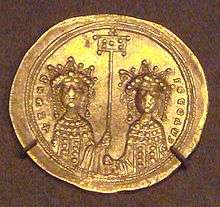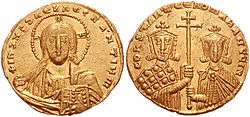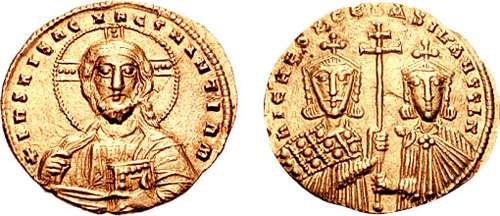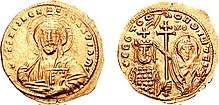Constantine VIII
| Constantine VIII | |||||
|---|---|---|---|---|---|
| Emperor and Autocrat of the Romans | |||||
|
Basil II and Constantine VIII, holding a patriarchal cross | |||||
| Emperor of the Byzantine Empire | |||||
| Reign |
962–1025[notes 1] 15 December 1025 – 11 November 1028 | ||||
| Predecessor | Basil II | ||||
| Successor | Romanos III Argyros | ||||
| Born | 960 | ||||
| Died | 11 November 1028 | ||||
| Spouse | Helena | ||||
| Issue |
Eudokia Zoë Theodora | ||||
| |||||
| Dynasty | Macedonian dynasty | ||||
| Father | Romanos II | ||||
| Mother | Theophano | ||||
Constantine VIII (Greek: Κωνσταντῖνος Η΄, Kōnstantinos VIII) (960 – 11 November 1028) was the Byzantine Emperor from 15 December 1025 until his death in 1028. He was the son of Emperor Romanos II and Empress Theophano. He was nominal co-emperor for 63 years from 962, successively with his father, his stepfather Nikephoros II Phokas, his uncle John I Tzimiskes, and his elder brother Basil II.
Basil II died childless in 1025 and thus left the rule of the Byzantine Empire in Constantine's hands. Constantine had no interest in politics, statecraft or the military. His brief reign is said to have been "an unmitigated disaster", sparking "a collapse of the military power of the Empire".
Family

Constantine's father, Romanos II, was the sixth Byzantine emperor of the Macedonian dynasty. After the death of his first wife, Bertha (who took the name Eudocia), daughter of Hugh of Arles, he fell in love with and married an innkeeper's daughter from the Peloponnese, Theophano. Contemporaries called Theophano the most beautiful woman in Christendom as well as ambitious, an inveterate schemer and utterly amoral. She bore Romanos four children, including Constantine, born in 960, and his elder brother Basil, born in 958.[1] His sister Anna's hand was considered such a prize that Vladimir I of Kiev converted to Christianity in order to marry her.[2] Aged eight, Constantine was engaged to a daughter of Emperor Boris II of Bulgaria but in the end he married a Byzantine aristocrat named Helena, daughter of Alypius. By Helena he had three daughters: Eudokia, who became a nun; Zoë, who was empress for 22 years; and Theodora, who reigned for 18 months and was the last of the Macedonian line.[3]
Life



All coins show a haloed Christ on obverse
Childhood
Romanos died in 963, amidst rumours that Theophano had poisoned him; Constantine was three years old. Constantine and his brother had been crowned co-emperors by their father in March 962.[4] The widowed Theophano installed herself as regent for her sons and promptly purged the imperial government, appointing her own men. Passing over a bevy of suitors among Constantinople's courtiers, she made an alliance with Nikephoros Phokas. Nikephoros, a physically repulsive ascetic twice her age, was the greatest military hero of the Empire. In return for her hand, the childless Nikephoros gave his sacred pledge to protect her children and their interests. Nikephoros entered Constantinople three months after Romanus' death, breaking the resistance of Joseph Bringas, a eunuch palace official who had been Romanos' chief counsellor, in street fighting.[5] Nikephoros was crowned emperor in the presence of his nominal co-emperors, Constantine and Basil. A month later he married their mother.[6]
Six years later, Nikephoros was murdered at Theophano's instigation and her lover and co-conspirator John Tzimiskes was acclaimed emperor. Tzimiskes proposed to marry Theophano but the Empress had by then been too damaged by gossip and rumours, many of them accurate. Patriarch Polyeuktos refused to perform the coronation unless Tzimiskes removed the "scarlet empress" from the court. Tzimiskes calculated that his legitimacy would be better enhanced by church approval than betrothal to the unpopular empress and acceded to the Patriarch's demands. Theophano was sent into exile and Tzimiskes was crowned, again with Constantine and Basil as co-emperors.[7][8] He married Theodora, Constantine's aunt.[9]
Adulthood
Following the death of Tzimiskes in January 976, Basil and Constantine took power. Although the sixteen year old Constantine was nominally co-emperor it was clear that Basil was senior emperor as Basileus Basil II.[10] Constantine as a young man was tall and graceful, he was a superb horseman and trained his own horses. He competed in athletic and wrestling competitions, which he brought back into fashion. He had an excellent speaking voice and a good grasp of rhetoric. He was a gourmet and a gourmand.[11] He had no interest in politics, statecraft or the military and never developed any.[12] Constantine led troops alongside his brother in 989; the campaign ended without any combat and Constantine was not appointed to military command again.[13]
Emperor


Basil II had an illustrious reign, earning the sobriquet "Bulgar-slayer" (Bulgaroktonus). He died childless on 15 December 1025 and Constantine, a sixty-five-year-old widower, became sole emperor as Constantine VIII. He had been a co-emperor for sixty-three years but had always been content to enjoy the privileges of imperial status, without concerning himself with state affairs.[14] He spent his life in the search of pleasure and entertainment, or amusing himself with riding and hunting. He was "of frivolous disposition, he desired nothing more than to pass his life wallowing in extravagant pleasures."[15] Constantine as emperor carried on as he always had – hunting, feasting, and enjoying life – and avoided state business as much as possible.[15]
By the time he became emperor he had chronic gout and could hardly walk. He met challenges with impulsive cruelty, persecuting the nobility and ordering an orgy of torture; blinding was a favoured punishment for crimes real or imagined. He filled the senior court and state positions with nonentities. Within months the land laws of Basil II were dropped, under pressure from the Anatolian aristocracy. "Devoid of any semblance of moral fibre"[16] he would grant any concession.[16] Favouritism failed to win him friends and he persecuted the nobility when he felt threatened by conspiracy. The start of the decline of the Byzantine Empire has been linked to Constantine's accession to the throne.[17] His reign has been described as "an unmitigated disaster", "a break up of the system" and causing "a collapse of the military power of the Empire".[18][10]
He ruled for less than three years before his death on 11 November 1028. On his deathbed, and without a male heir, Constantine recalled the senior aristocrat Constantine Dalessenos, Duke of Antioch, to the capital in order to marry his oldest daughter Zoë. The Dalassenus were one of the few powerful patrician families who had been unswervingly loyal to the Macedonian dynasty.[19] Constantine Dalassenos set out from his estates in the Armeniac Theme, but before reaching Constantinople the situation changed: the emperor's advisors preferred a weak ruler whom they could control, and, typically, Constantine was persuaded. He choose Romanos Argyros instead, forcing him to divorce his wife and marry Zoë. The wedding took place only three days before Constantine died on 11 November 1028. Romanos was crowned Romanos III (r. 1028–1034) four days later.[20][21]
See also
Notes
- ↑ Co-Emperor with Romanos II (962–963), Nikephoros II Phokas (963–969), John I Tzimiskes (969–976) and Basil II (962–1025)
References
- ↑ Norwich 1991, p. 174.
- ↑ SkylitzesWortley 2010, p. 319 (footnote).
- ↑ Garland 1999, pp. 165–66.
- ↑ Brand, Charles M.; Cutler, Anthony (1991). "Constantine VIII". In Kazhdan, Alexander. The Oxford Dictionary of Byzantium. Oxford and New York: Oxford University Press. pp. 503–504. ISBN 0-19-504652-8.
- ↑ Ostrogorsky 1957, p. 284.
- ↑ Norwich 1991, pp. 174–75, 183–190.
- ↑ Ash 1995, p. 248.
- ↑ Norwich 1991, p. 240.
- ↑ Ostrogorsky 1957, p. 261.
- 1 2 Ostrogorsky 1957, p. 264.
- ↑ Norwich 1991, pp. 267, 269.
- ↑ Norwich 1991, p. 231.
- ↑ Norwich 1991, pp. 242–43.
- ↑ Brand, Charles M.; Cutler, Anthony (1991). "Constantine VIII". In Kazhdan, Alexander. The Oxford Dictionary of Byzantium. Oxford and New York: Oxford University Press. pp. 503–504. ISBN 0-19-504652-8.
- 1 2 Ostrogorsky 1957, p. 265.
- 1 2 Norwich 1991, p. 268.
- ↑ Ostrogorsky 1957, p. 283.
- ↑ Norwich 1991, pp. 283, 268.
- ↑ Norwich 1991, p. 269.
- ↑ Patlagean 2007, pp. 131–132; Treadgold 1997, p. 584.
- ↑ Ostrogorsky 1957, p. 322.
Bibliography
Primary sources
- Psellus, Michael (1979). Chronographia [Chronicle]. Penguin classics (Fourteen Byzantine Rulers: The Chronographia of Michael Psellus ed.). London: Penguin. ISBN 978-0-14-044169-7.
- Thurn, Hans, ed. (1973). Ioannis Scylitzae Synopsis historiarum [John Scylitzes: A Synopsis of Histories]. Berlin-New York: De Gruyter. ISBN 978-3-11-002285-8.
Secondary sources
- Ash, John (1995). A Byzantine Journey. London: I.B. Tauris. ISBN 978-1-86064-015-5.
- Garland, Lynda (1999). Byzantine Empresses: Women and Power in Byzantium, AD 527–1204. London and New York: Routledge. ISBN 978-0-415-14688-3.
- Norwich, John (1991). Byzantium: the Apogee. London: Penguin. ISBN 978-0-670-80252-4.
- Ostrogorsky, George (1957). History of The Byzantine State. New Brunswick: Rutgers University Press. OCLC 422217218.
- The Oxford Dictionary of Byzantium. Three volumes. London: Oxford University Press. 1991. ISBN 978-0-19-504652-6.
- Patlagean, Évelyne (2007). Un Moyen Âge Grec: Byzance, IXe–XVe siècle (in French). Paris, France: Albin Michel. ISBN 978-2-226-17110-8.
- Skylitzes, John; Wortley, John (2010). A Synopsis of Byzantine History, 811–1057. Cambridge: Cambridge University Press. ISBN 978-0-521-76705-7.
- Treadgold, Warren (1997). A History of the Byzantine State and Society. Stanford: Stanford University Press. ISBN 0-8047-2630-2.
External links
| Wikimedia Commons has media related to Constantine VIII. |
Constantine VIII Born: 960 Died: 15 November 1028 | ||
| Regnal titles | ||
|---|---|---|
| Preceded by Basil II |
Byzantine Emperor 962–1028 with Romanos II (962–963) with Nikephoros II Phokas (963–969) with John I Tzimiskes (969–976) with Basil II (962–1025) |
Succeeded by Zoe and Romanos III |